This chapter will cover the basics of how to install SQL Server 2016 to properly go through the examples in this book. The version of SQL Server used through out this book is the Developer edition of SQL Server 2016. It's available for free as long as you subscribe to Visual Studio Dev Essentials.
Following are the steps to download and install SQL Server 2016.
- Open your browser and paste this link: https://www.visualstudio.com/dev-essentials/. The following page appears in your browser:

- Click on
Sign invisible at the right (top) to log in Visual Studio Dev Essentials. If you don't have an existing subscription, you can create one by clicking on theJoin or access nowbutton in the middle of the page, as shown in the following screenshot:

- You are directed to the
My Informationpage. Click onMy Benefitsat the top of the page to access the download section as shown in the following screenshot:

- Click on the
Downloadlink in theMicrosoft SQL Server Developer Editiontile as highlighted in the following screenshot:

- This will redirect you to the
SQL Server 2016 Developer Editionpage. Click on the green arrow to start downloading the ISO file as shown in the following screenshot:

- Due to its pretty large size, the file may take some time to download. The following screenshot is shows 44% done and 10 seconds left to download. This is due to the fact that the file is being downloaded on an Azure VM. It might take longer for you to download it. Depending on your browser, you should see the file downloading as in the following screenshot:

- Don't mount the ISO file for now. We have to install an external component described in the next section before we proceed with the installation of SQL Server.
Java Runtime Engine (JRE) is required for PolyBase installations. SQL Server PolyBase is the technology that allows data integration from other sources other than SQL Server tables. PolyBase is used to access data stored in Hadoop File System (HFS) or Windows Azure Storage Blob (WASB).
As you will see later in this book, SSIS can now interact with these types of storage natively but having PolyBase handy can save us valuable time in our ETL.
For this recipe you will need to have access to the internet and have administrative rights on your PC to install JRE.
- To download JRE, follow this link: http://www.oracle.com/technetwork/java/javase/downloads/index.html . You will see the screen shown in the following screenshot:

This directs you to the Java SE Download at Oracle.
- Click the download link in the JRE section as shown in the following screenshot:

- You must accept the license agreement to be able to select a file to download. Select
Accept License Agreementas indicated in the following screenshot:

- Since SQL Server 2016 only exists in a 64-bit version, download the 64-bit JRE. The version of Java SE runtime environment might be different from the one show in the screenshot, which is the one available at the time this book was written:.

- Once downloaded, launch the installer. Click on
Runas shown in Edge browser. Otherwise, go to yourDownloadsfolder and double-click on the file you just downloaded (jre-8U102-windows-x64.exein our case); you will see the following window:

- The Oracle JRE installation starts. Click on
Install. The following screen appears. It indicates the progress of the JRE installation.

- Once the installation is completed, click on
Closeto quit the installer:

You are now ready to proceed to install SQL Server 2016. We'll do that in the next section.
Microsoft integrated PolyBase in SQL Server 2016 to connect almost natively to the Hadoop and NoSQL platforms. Here are the technologies it allows us to connect to:
- HDFS (Hortonworks and Cloudera)
- Azure Blob Storage
Since Hadoop is using Java technology, JRE is used to interact with its functionalities.
This section will go through the installation of SQL Server engine, which will host the database objects used throughout this book.
These are the features available for SQL Server setup:
- Database engine: It is the core of SQL Server. It manages the various database objects such as tables, views, stored procedures, and so on.
- Analysis services: It allows us to create a data semantic layer that eases data consumption by users.
- Reporting services (native): It allow us to create various reports, paginated, mobile, and KPI's for data consumption.
- Integration services: It is the purpose of this book, SQL Server data movement service.
- Management tools: We'll talk about these in the next section.
- SQL Server Data Tools: We'll talk about these in the next section.
This recipe assumes that you have downloaded SQL Server 2016 Developer Edition and you have installed Oracle JRE.
- The first step is to open the ISO file that you downloaded from the Microsoft Visual Studio Dev Essentials website as described in the SQL Server 2016 download recipe. If you're using Windows 7, you'll need to extract the ISO file into a folder. Third-party file compression utilities such as WinRAR, WinZip, or 7-Zip (and there are many more) can handle ISO file decompression. The setup files will be uncompressed in the folder of your choice. In other versions of Windows such as Windows 8.1, Windows 10, or Windows Server 2012 and beyond, simply double-click on the ISO file that you have downloaded previously and a new drive will appear in Windows Explorer.
- Double-click on the file named
Setup.exeto start the SQL Server installation utility. The features we're going to install are as follows:New SQL Server stand-alone installation or adding features to an existing installation: This will install a local instance (service) of SQL Server on your PCSQL Server Management Tools: The tools used to create, query, and manage SQL Server objectsInstall SQL Server Data Tools: This contains Visual Studio templates to develop and deploy SQL Server databases, integration services packages, analysis service cubes, and reporting services
- From the installation utility, select the
New SQL Server stand-alone installation...option as shown in the following screenshot. A new SQL Server setup window opens.
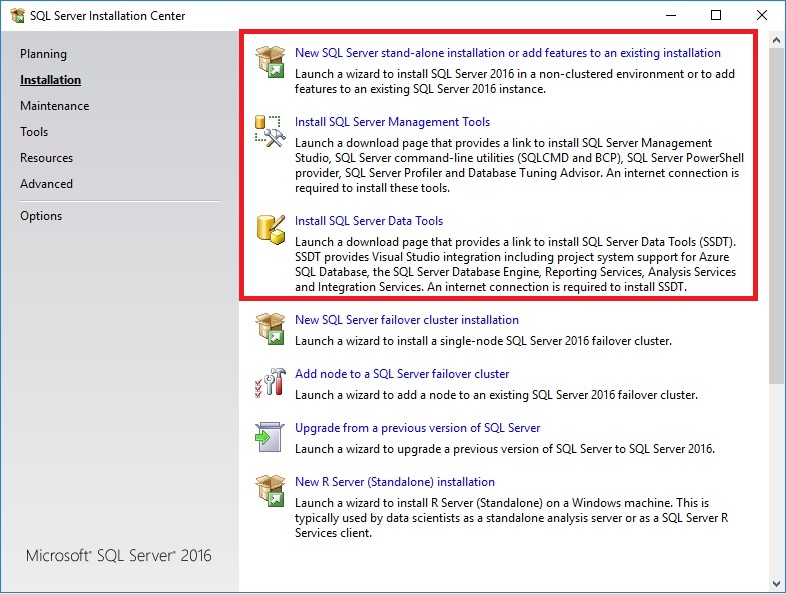
- The
Product Keypage allows us to specify an edition to install. Since we're going to use the free Developer Edition, clickNextto go to the next page, as shown in the following screenshot:
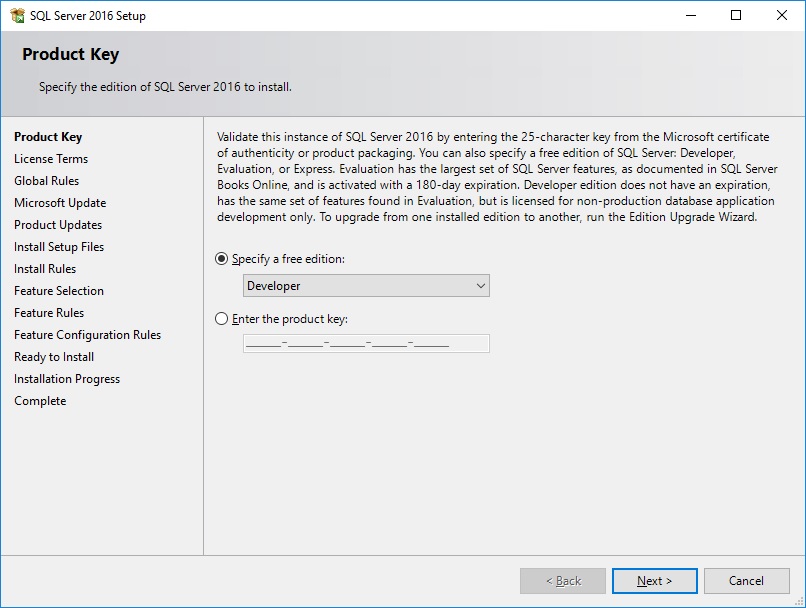
- Accept the license terms and click
Nextto go to the next page, as shown in the following screenshot:
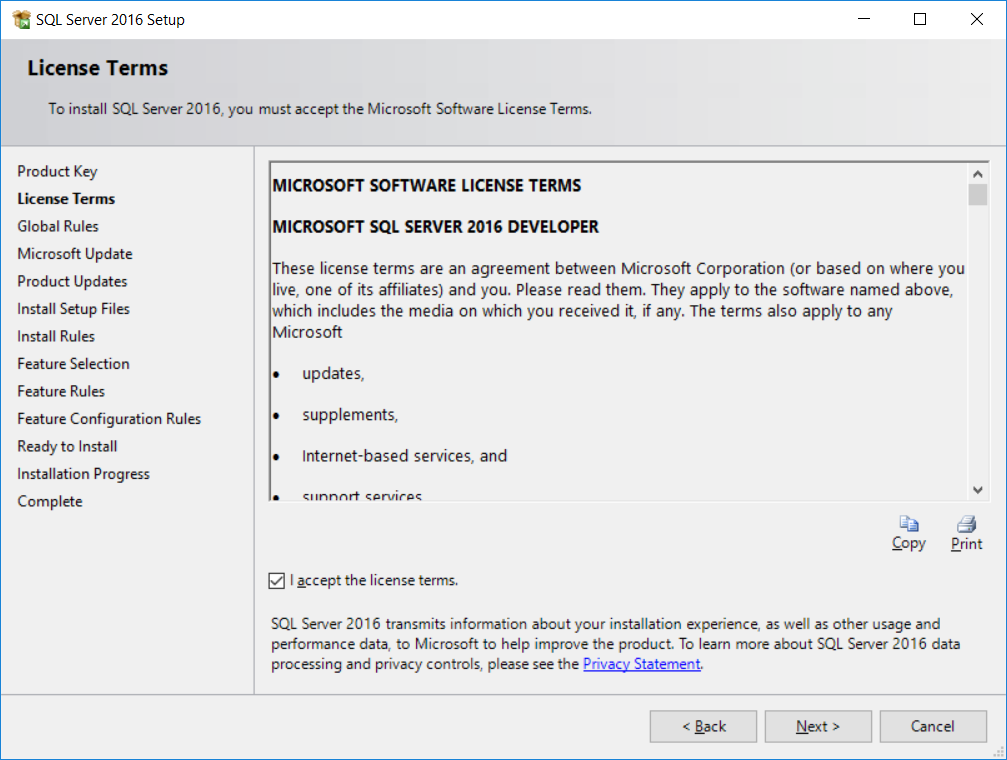
- In this step, the SQL Server setup will check for product updates and will integrate itself into Windows update checks that are done regularly on your machine. This step is not mandatory but it's better to use the latest code. Check
Use Microsoft Update...and clickNext, as shown in the following screenshot:
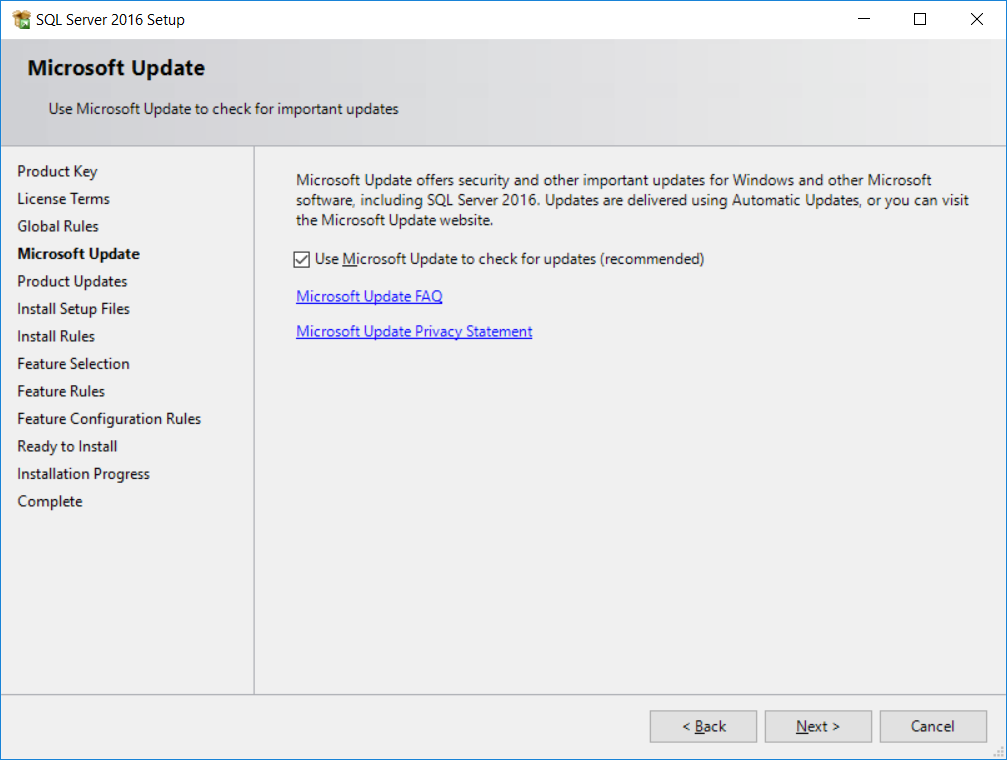
- Some updates might be found during setup. You can get more information on these updates by clicking the link in the
More Informationcolumn. ClickNextto install the updates, as shown in the following screenshot:
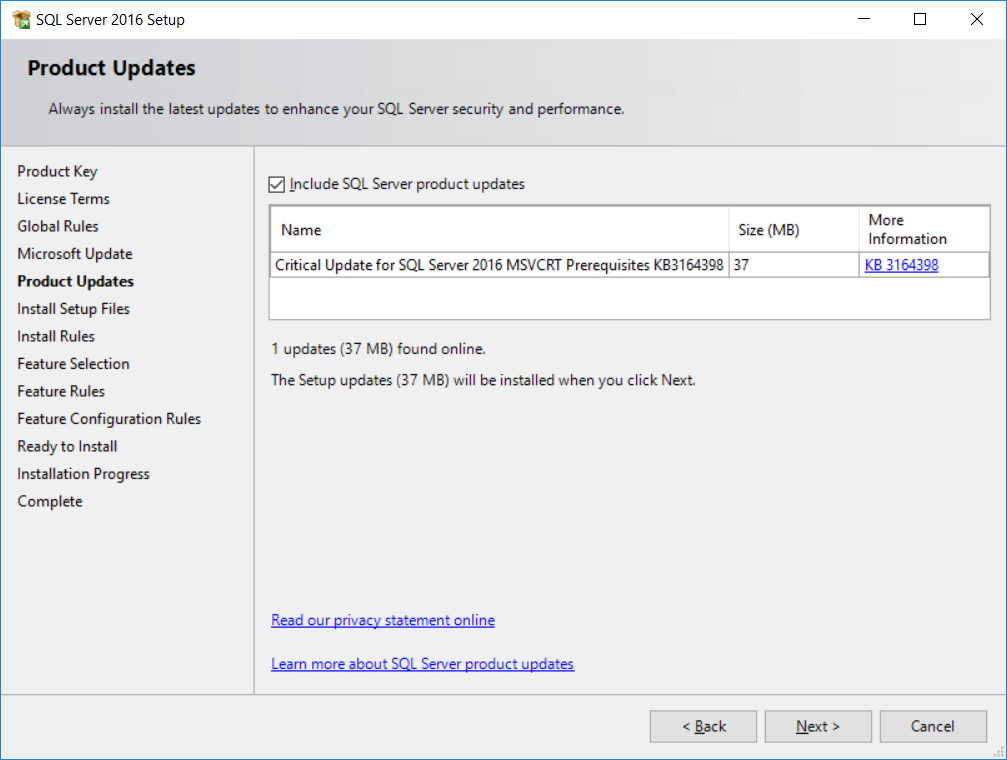
- This step simply checks to make sure that the latest version of SQL Server is installed. Click
Nextonce the setup files are installed, as shown in the following screenshot:
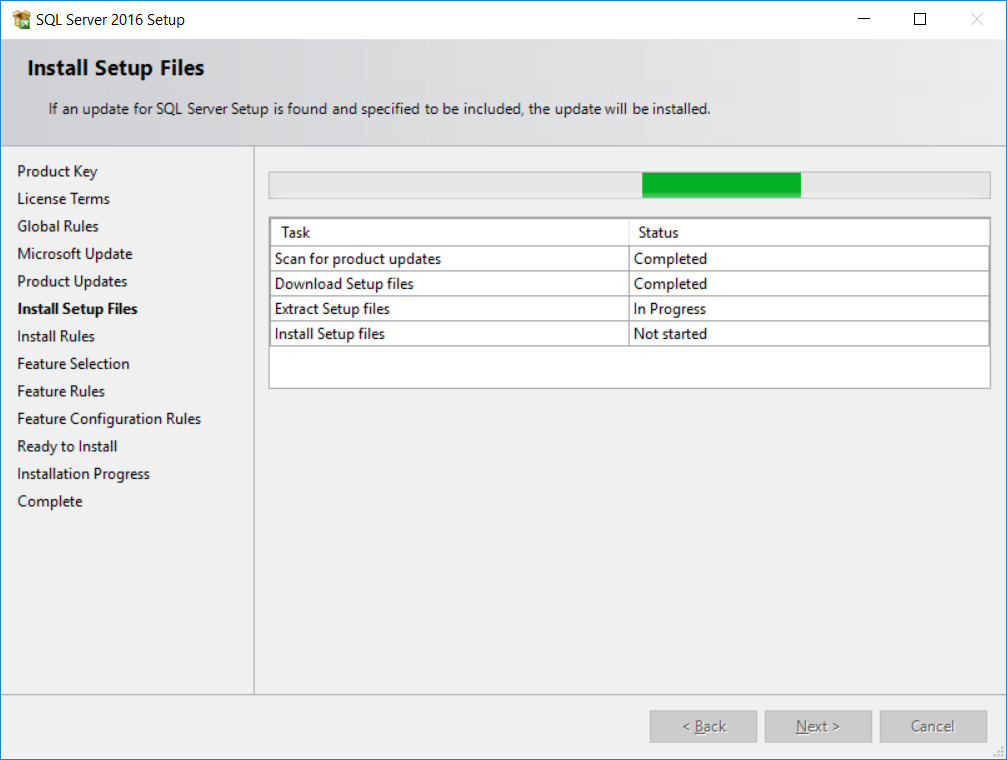
- SQL Server setup will check several rules to ensure that the computer where we want to install it is setup properly. You might get a warning due to Windows firewall rules. This tells you that the port (
1433by default) is not open and SQL Server won't be available from outside your PC. Don't worry about it. Since we'll be using SQL Server from our PC only, we do not need to open any ports for now. ClickNextto advance to the feature selection page, as shown in the following screenshot:
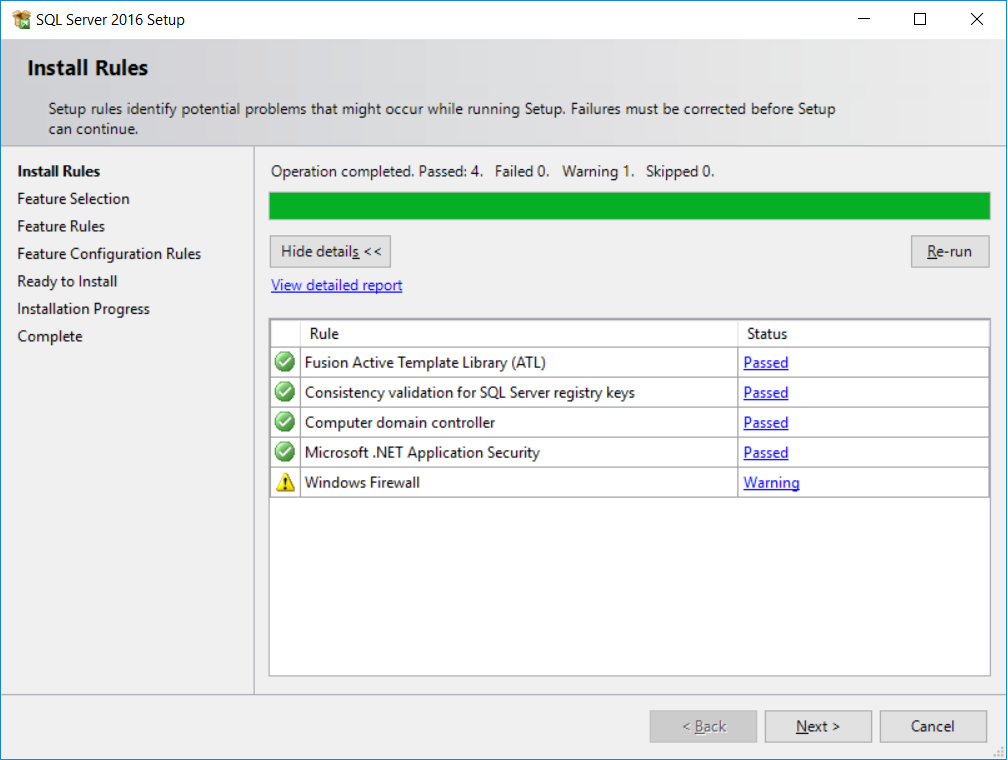
- Select all features checked in the preceding screenshot and click
Next, as shown in the following screenshot:
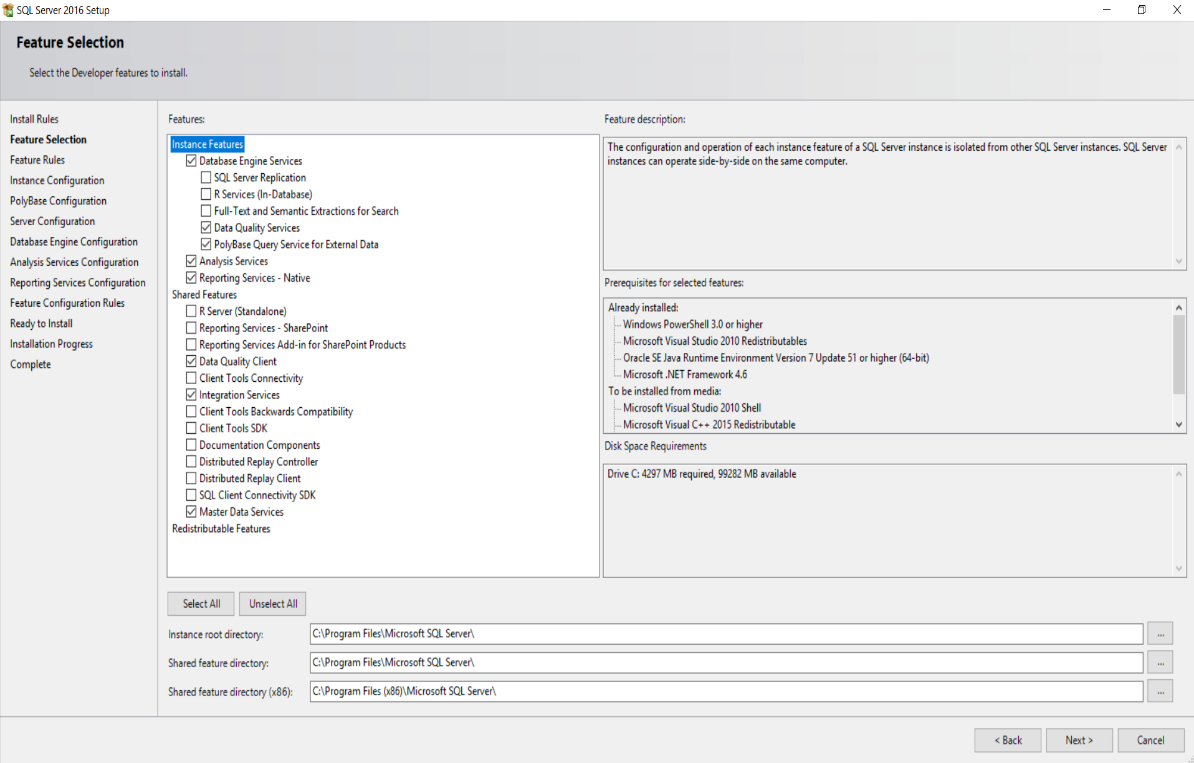
- Instance configuration allows to specify a name for the SQL Server service. This is done by selecting the
Named instanceradio button. Since we'll only use one SQL Server instance, leaveDefault instanceselected and clickNext, as shown in the following screenshot:
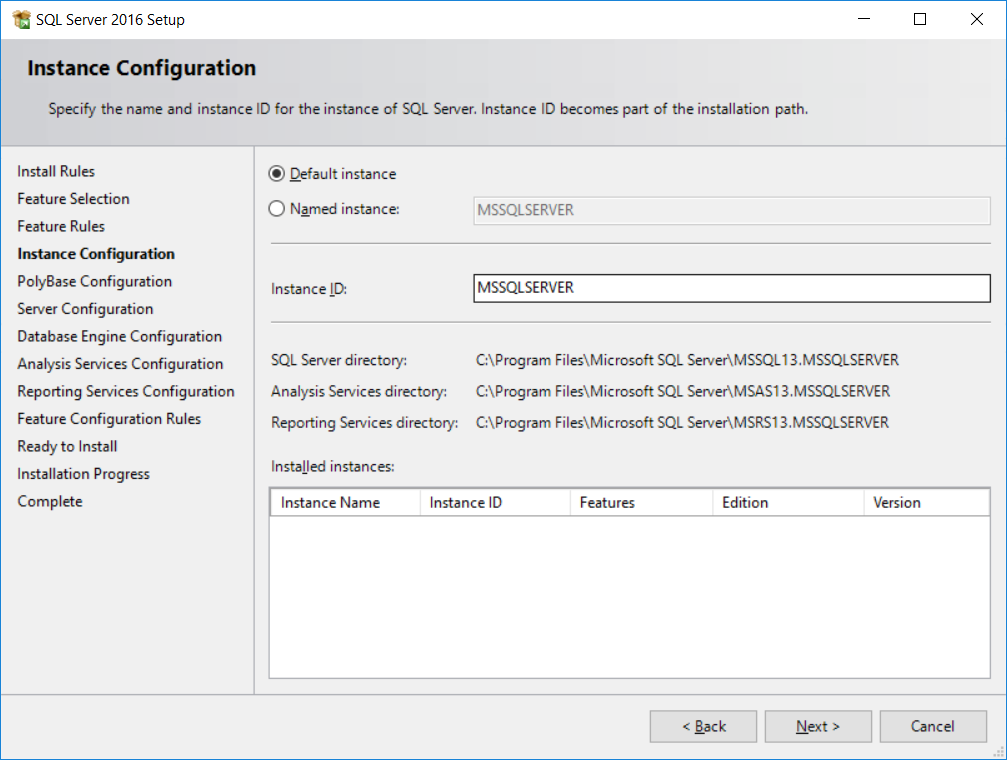
- This page allows SQL Server to be part of a PolyBase scale out group. Since we're only setting up SQL Server PolyBase to be used by one instance, leave the default
Use this SQL Server as standalone PolyBase-enabled instanceand clickNext, as shown in the following screenshot:
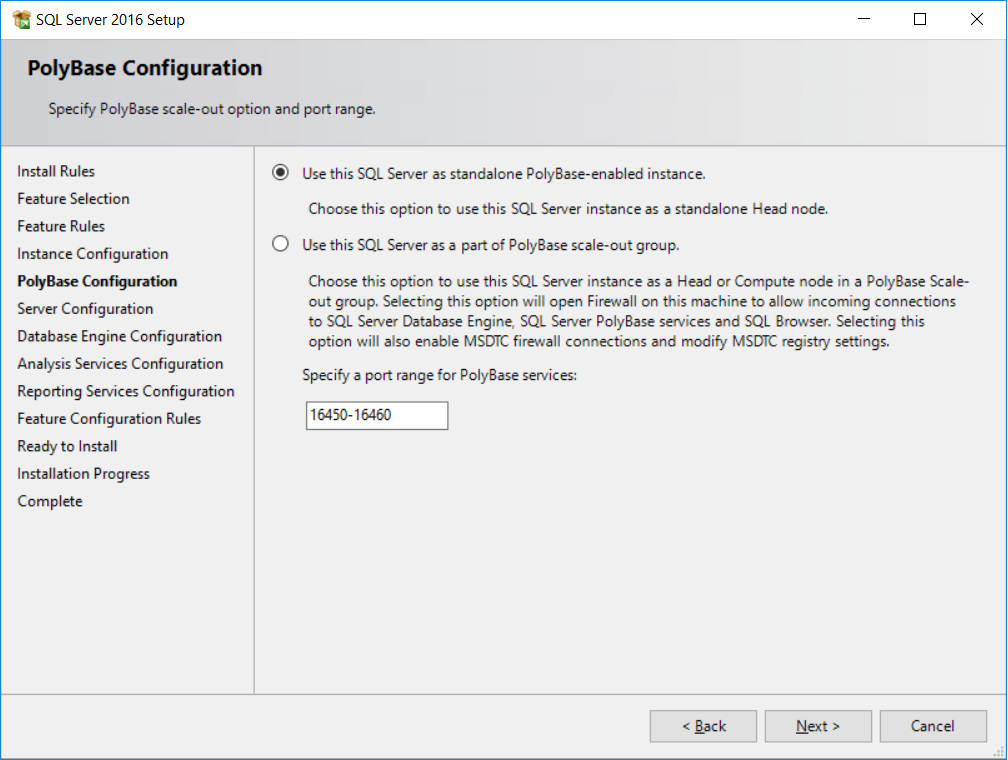
- Now for server configuration. This step allows us to specify distinct or specific service accounts. Since we're installing SQL Server on a single development machine, we'll use the default accounts, as shown in the following screenshot:
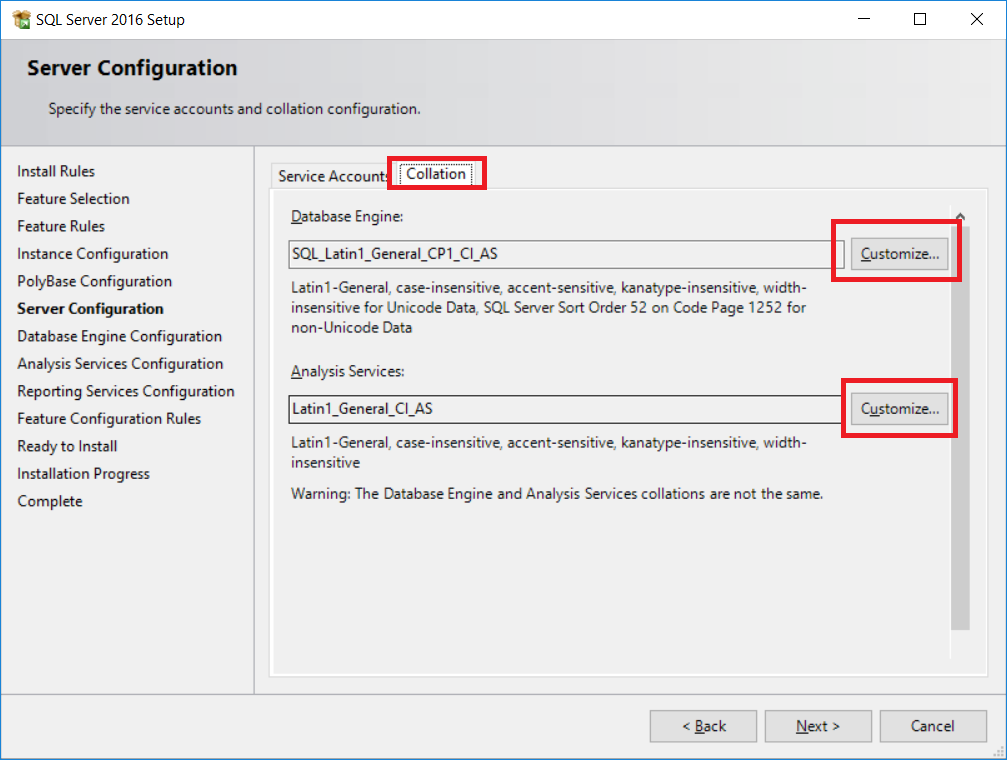
- Click on the
Collationtab as highlighted on the preceding screenshot. The default collation used by SQL server isSQL Latin1_General_CP1_CI_AS. This is a legacy collation. The choice of the collation is important for character string columns. The latest (fewer bugs) collation isLatin1_General_100. The last charactersCIandASare for case-insensitive and accent-sensitive, respectively. - We'll change the collation defaults. Click
Customize...at the end ofSQL Latin1_General_CP1_CI_AI, as shown in the following screenshot:
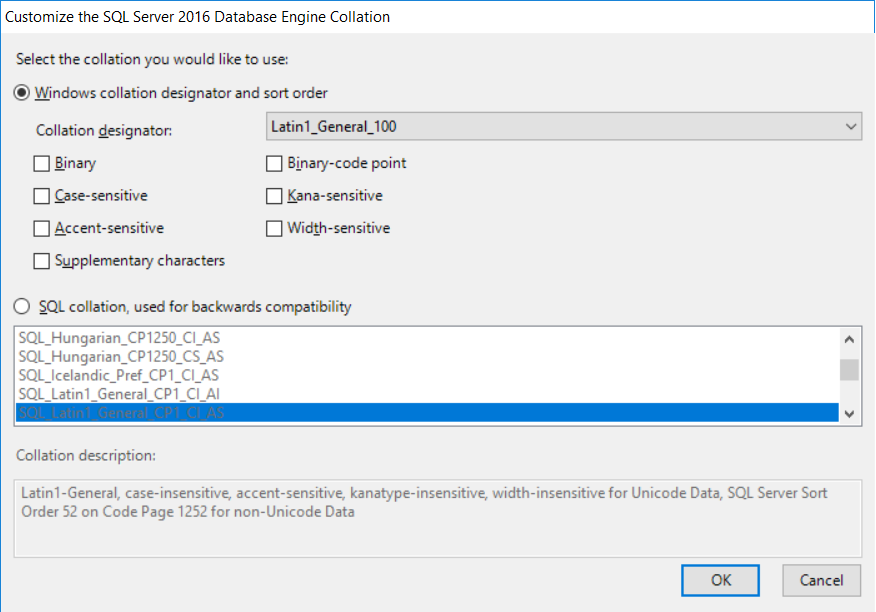
- As stated previously, we'll use the Windows collation designator
Latin1_General_100. UncheckAccent-sensitive. This allows SQL Server to sort character columns without using accentuated characters. For example, suppose that our application has aFirstNamecolumn and we have the following first names:JoelJoël
- If we query SQL Server filtering on
FirstName = 'Joel'with theAccent-sensitivecollation option, we end up retrieving the valueJoelonly. If we do not select theAccent-sensitivecollation option, we will get both values. - Click
OKwhen done to return to the previous screen. We'll do the same for analysis services; clickCustomize...to customize analysis service collation, as shown in the following screenshot:
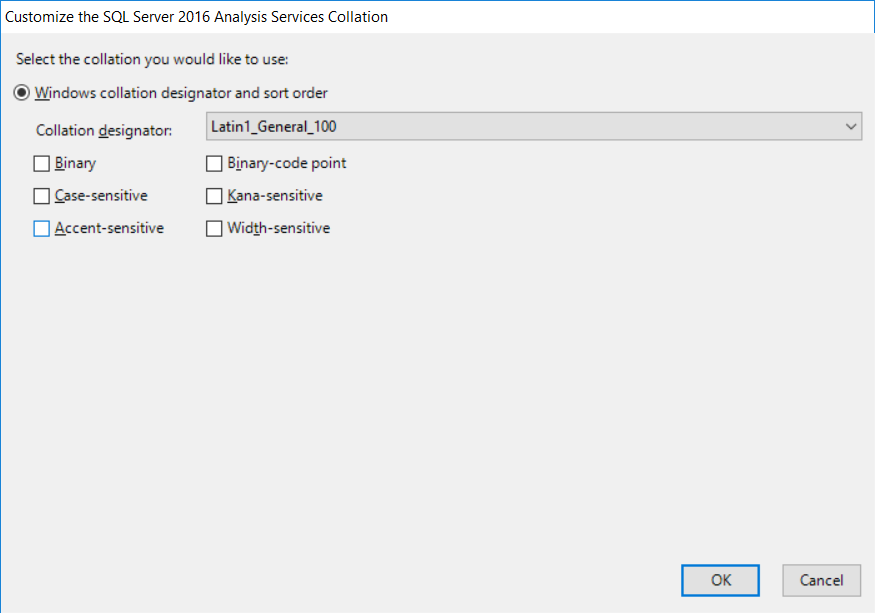
- Again, choose
Latin1_General_100in Collation designator and uncheck theAccent-sensitivecheckbox. ClickOKto return to the previous screen. Click onNext, as shown in the following screenshot:
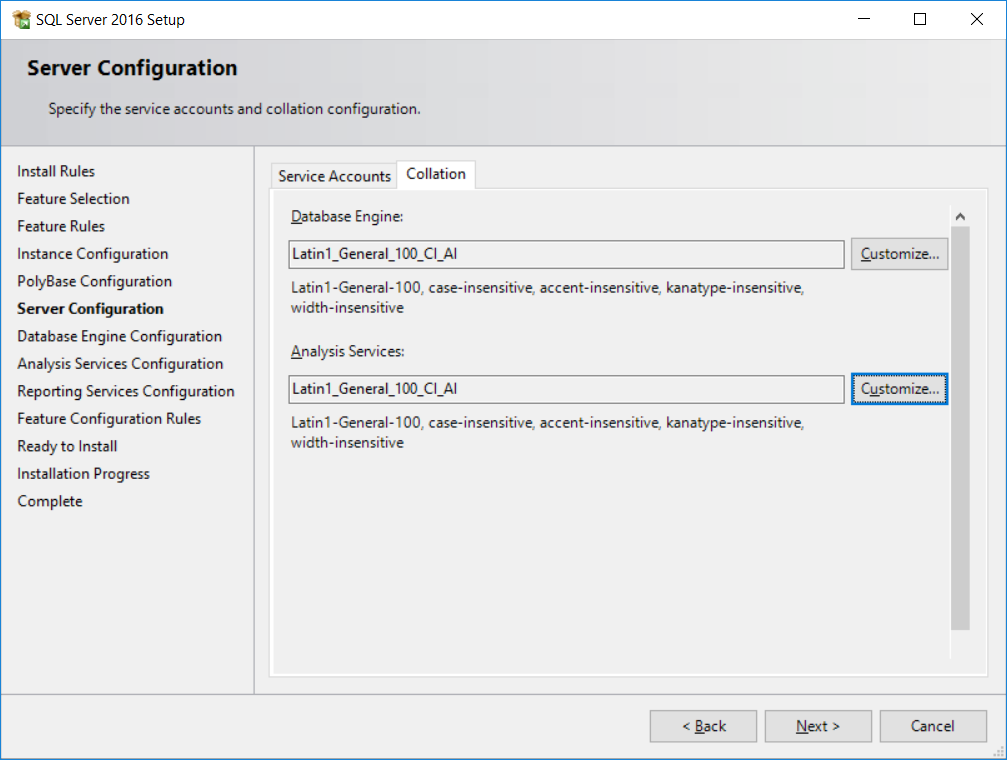
- This will direct you to the following screen. For the database engine configuration, we'll use
Mixed Modeto allow us to use SQL Server logins and Windows logins. The default authentication isWindows authentication mode, which is more secure than SQL Server authentication because it uses the Kerberos security protocol, password, and account lockout policies, and password expiration. Make sure you use strong passwords for SQL Server logins. By default, password policy, password expiration, and user must change password at next login are turned on also for SQL Server login. You should not disable the password policy and the password expiration. Select theMixed Moderadio box and enter a password for the SA account. Click onAdd Current Useras shown in the screenshot to add your Windows account as an administrator of the instance. You'll have all rights on it. ClickNext, which will direct you to theAnalysis Services Configurationwindow, as shown in the following screenshot:
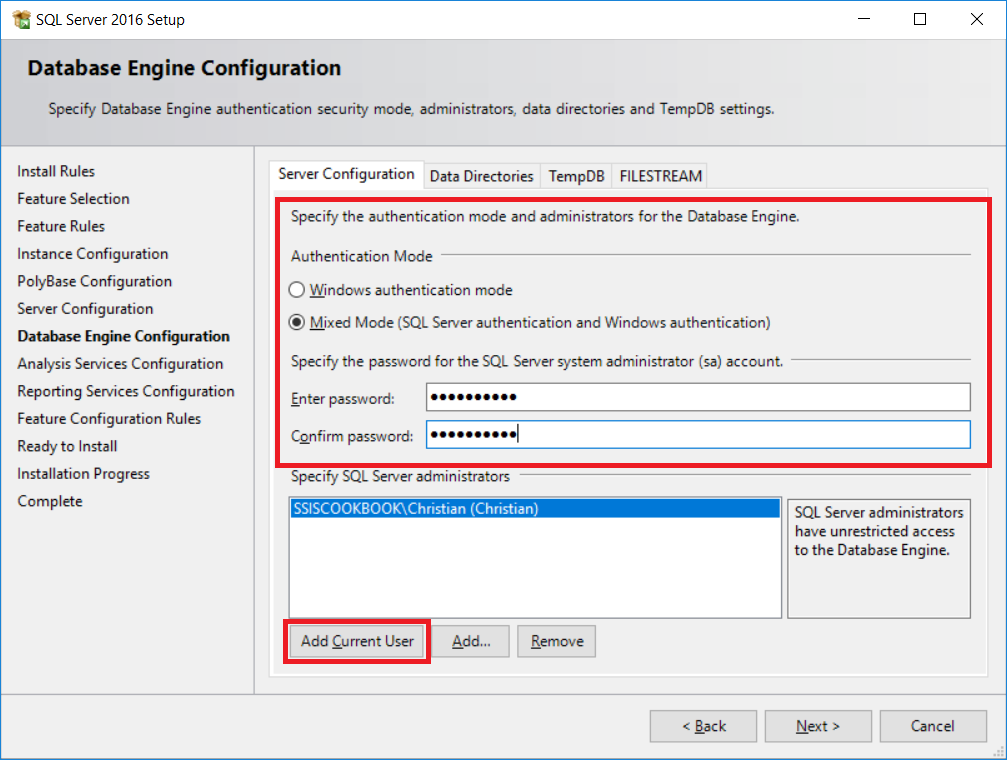
- For analysis services configuration, the
Server Modewe'll use isTabular Modeand again click onAdd Current Useras shown in the following screenshot to add your Windows account as an administrator of the service. ClickNext.
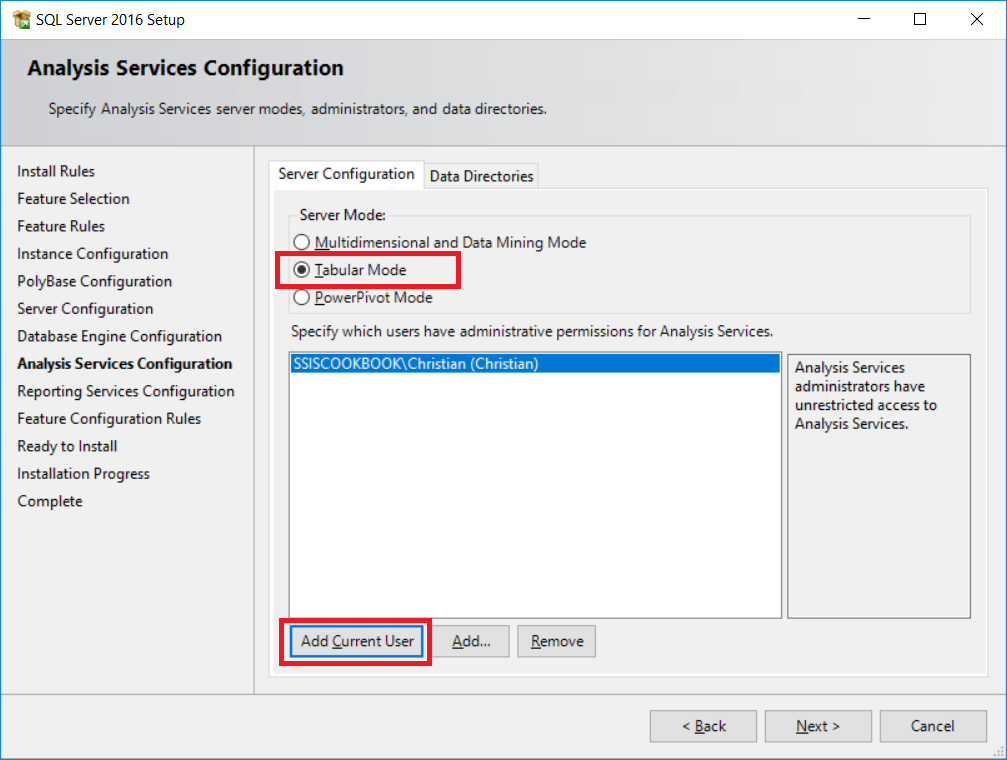
- For the Reporting services configuration, leave the default values and click
Next, as shown in the following screenshot:
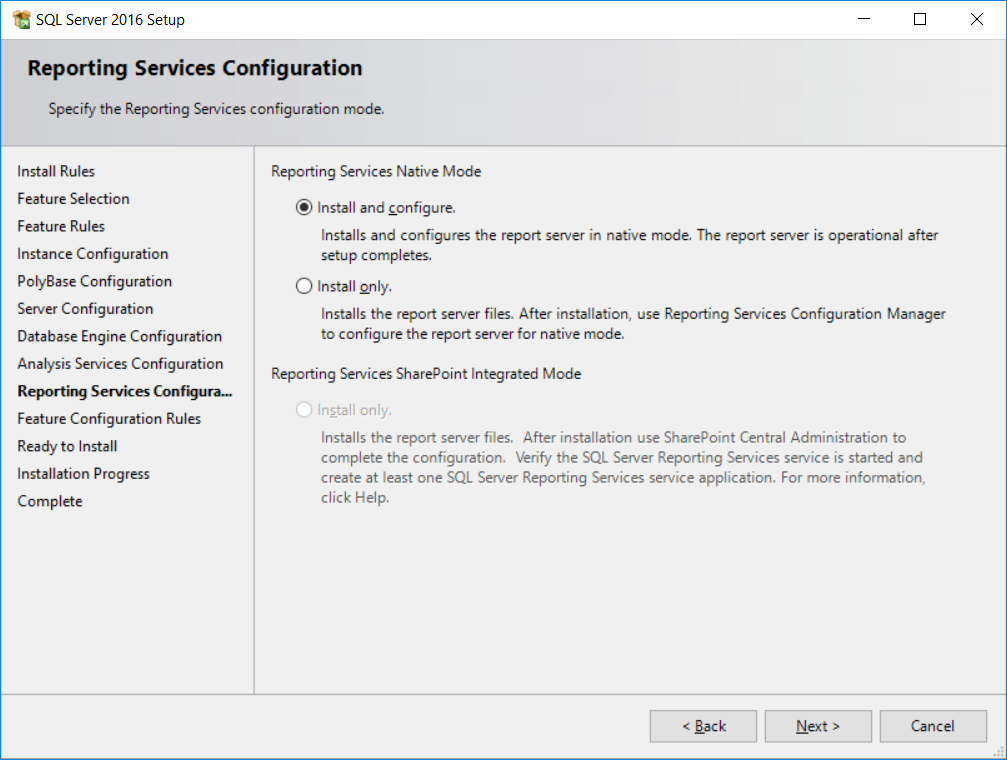
- We're finally ready to install. Click
Installto start the installation process, as shown in the following screenshot:

- The following screenshot shows the installation progress:
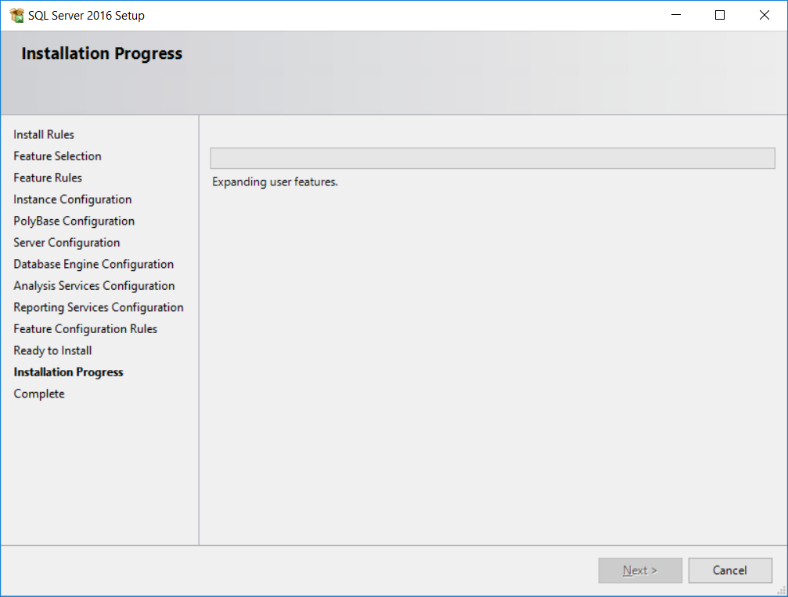
- Once the installation is complete, you get the following screen:
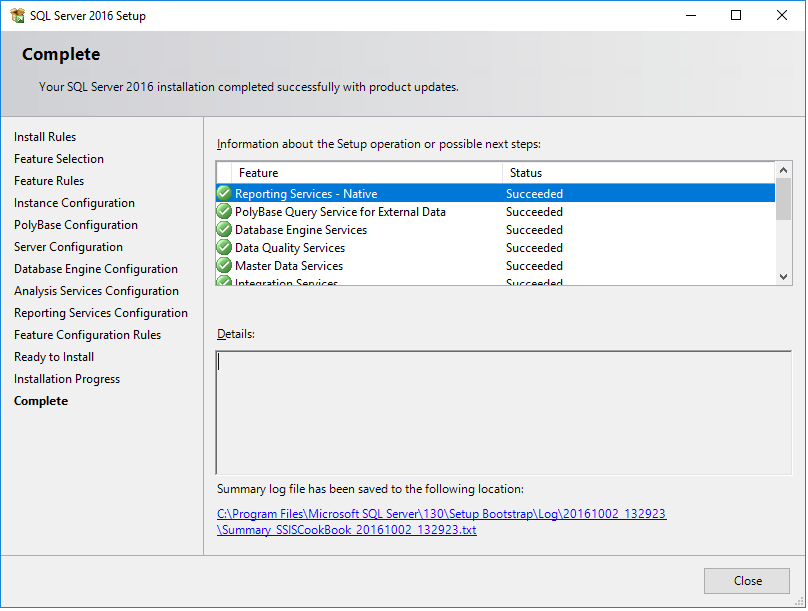
We're done. We just installed SQL Server 2016! In the next section, we'll install SQL Server Management Studio.
SQL Server Management Studio is a separate download from SQL Server. This program will allow us, among other things, to create database objects and query SQL Server. Without this tool, we wouldn't be able to manage SQL Server databases easily.
- To download and install SQL Server Management Studio, click on Install SQL Server Management Tools, as shown in the following screenshot:

- The SSMS download page opens in your browser. Click
Download SQL Server Management Studio(the latest version) to start the download process. Once downloaded, run the installation as shown in the following screenshot:

- Click
Install, as shown in the following screenshot:

- This will direct you to the Microsoft SQL Server Management Studio installation screen as follows. The installation is in progress; it may take several minutes to complete.

- Click
Closeto close the installation wizard, as shown in the following screenshot:

The last part of our SQL Server 2016 setup is to install SQL Server Data Tools. This will install a Visual Studio Shell that contains BI templates necessary for the following:
- SQL Server integration services
- SQL Server analysis services
- SQL Server reporting services
- Database object management
We'll use SSDT throughout this book to create, deploy, and maintain our SSIS packages and some databases.
- From the SQL Server 2016 setup utility, click on
SQL Server Data Tools (SSDT). This will open theDownload SQL Server Data Tools (SSDT)download page in your browser as shown in the following screenshot:

Here, there are two choices:
Install SSDT only: This is the simplest scenario. It only installs SSDT and a development shell.
Install Visual Studio and SSDT: You choose this if you plan to use source control inside Visual Studio or when you want to implement different types of development (.NET, Python, and so on) such as SSIS/SSAS/SSRS development. Since we'll talk about custom components in this book, we'll install Visual Studio Community Edition. This version is free for individuals.
- Click on the
Download Visual Studio Community 2015link to download the Visual Studio installer. - Once downloaded, click on
Runto launch the Visual Studio installer. - Accept the default installation type and click
Installto start the installation process. This will give you the following window:

- Once the installation is completed, since we haven't installed SSDT, don't launch Visual Studio yet. Close this window. We'll install SQL Server Data Tools first. Return to the browser window and click
Download SQL Server Data Tools for Visual Studio 2015as shown in the following screenshot:

- This will direct you to the SSDT download screen shown as follows:

- From the browser page that opens, choose
English (United States). The SSDT setup executable file download starts. Since it's a small file, it takes only a few seconds to download. Once the download completes, clickRunor double-click on the newly downloaded file to start SSDT installation. Accept the defaults and clickNextto proceed to the next step, as shown in the following screenshot:

- Accept the license agreement by checking the
I agree to the license terms and conditionsand clickInstall, as shown in the following screenshot:

- The SSDT installer will download the necessary files and proceed to the installation, as shown in the following screenshot:

- Once the installation completes, you might have to restart your computer. If that's the case, restart it, as shown in the following screenshot. Once that's done, look for SQL Server Data Tools in your Start menu and launch it.

- From the
Filemenu, selectNew Project. Once theNew Projectwindow appears, you will seeBusiness Intelligencein the project templates, as shown in the following screenshot:

- Close SSDT; we're done with it for now.
SQL Server Management Studio has been installed in this chapter in the SQL Server Management Studio installation recipe. We'll now test whether we're able to connect to our local instance.
This recipe assumes that you have successfully installed SQL Server 2016 Developer Edition as well as SQL Server Management Studio.
- Look for SQL Server Management Studio in your Start menu and launch it.
- Once the application opens, you should see your PC's name in the
Server Namefield. Click onConnect. SSMS will now connect to your local SQL Server instance, as shown in the following screenshot:

- You are now able to connect to your local SQL Server instance, and we're now ready to begin work! You will get the following screen:





















 Download code from GitHub
Download code from GitHub



